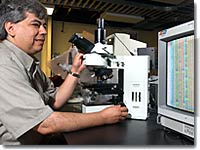Carlos Gutierrez
As a child Carlos Gutierrez, now a materials physicist at Texas State University, San Marcos, wondered why there weren't more Hispanics in physics. He asked his teachers if they knew of any Hispanic physicists, but they couldn't name any. Lacking role models, Gutierrez wasn't sure if he was cut out to be a physicist. “It really does affect a young person thinking about being a physicist if they see no one of their nationality or ethnicity that are actually functioning physicists,” he says.
 Carlos Gutierrez in his lab.
Carlos Gutierrez in his lab. Gutierrez didn't worry that physics might be unfriendly to minorities, he says, “but I did wonder whether or not there was just something different in the way that people were put together that made certain nationalities better for physicists. Now I'm a lot wiser, and I realize that a lot of it has to do with your background, in terms of the educational opportunities that you have.”
In his hometown of San Antonio, Texas, most of his friends didn't know what a physicist really did. Many bright Hispanics went into engineering or medicine, which they viewed as more tangible subjects with better financial rewards, says Gutierrez.
Gutierrez traces his first interest in science to folk tales his grandmother, who has Aztec ancestry, told him when he was young. The stories often involved astronomy, inspiring his dream of becoming an astrophysicist. The young Gutierrez also visited the laboratory of his aunt, a biochemist, and thought it would be neat to have his own lab one day.
He obtained a B.S. in physics from the University of Dallas in 1983, and then went on to graduate school at Johns Hopkins University in Baltimore, which he chose for its role as the headquarters of the Space Telescope Science Institute.
While in graduate school, Gutierrez changed his research specialty from astrophysics to materials physics. “I just wanted to know how everything worked. I was at that time very interested in the instrumentation, and I guess that's why I ended up doing what I do now in materials physics. The things I found were most interesting were things that dealt with observation and detection technology-- how satellites were constructed, how sensors were put together, how they measure the magnetic field in space and the radiation spectra, and all that kind of stuff. I found out that's the stuff that really fascinated me.”
Now a professor at Texas State University, San Marcos, Gutierrez has the opportunity to work on applied projects, collaborating with engineers and with industry. “A lot of what I do naturally crosses over to engineering, and engineering's just a form of applied physics,” he says, “I don't really see a very sharp boundary.”
Gutierrez's recent work has been on thin film materials and nanostructures. He's looking for materials with interesting properties potentially useful for various sensor applications. Describing one particular project, Gutierrez says, “One of my new fascinations is new zinc oxide based semiconductor materials, which are based on the same core material component that you typically see in sunscreen. People are now realizing that if you could manufacture thin films of the stuff and engineer it, that it could be a useful semiconductor for various applications.”
One method Gutierrez uses to produce the material is a technique called ion beam sputtering. “Sputtering is a lot like atomic billiards, where the ion beam comes in and actually knocks off atoms from the target,” he explains. The atoms are then deposited on a nearby wafer, producing a very thin film. Among other experiments with the material, Gutierrez has been trying to introduce dopants that can make the material magnetic.
Though many scientists are interested in zinc oxide, the research is still in its early stages, says Gutierrez. “It just screams for people to do good materials physics research to see what is really there.”
In addition to basic research, Gutierrez enjoys collaborating with various companies in materials-related sensor and device applications. For instance, he is presently working with a new company, 4Wave Incorporated, to adapt new nanolayer fabrication strategies to develop the novel ZnO artificially engineered materials and other artificially-structured materials that have useful properties for telecommunications, MEMS (micro-electro-mechanical systems) sensor, and microelectronics device applications. Gutierrez has also recently engaged in collaborative ventures with start-up companies interested in magnetic and fluorescent nanoparticle detection schemes for bio-sensing applications. “I find working with these companies stimulating, and it helps me better prepare my students for potential industrial careers,” he says.
Now that he's a successful physicist, Gutierrez provides an example to minority youngsters wondering if physics is for them. Some schoolchildren have even used him as the subject of their school biography projects. Gutierrez also works to encourage minorities in science at his university as faculty advisor to the Society of Mexican-American Engineers and Scientists (MAES) student chapter and as an active member of societies such as the Society for the Advancement of Chicanos and Native Americans in Science (SACNAS). “I do what I can to let the students know that if they really are interested in physics, that it is a viable and exciting career,” he says.











